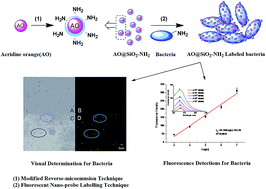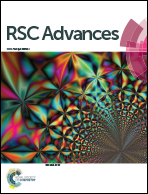Detection of Staphylococcus aureus using acridine orange-doped silica nanoparticles as a fluorescent label†
Abstract
In this paper, a new type of core–shell fluorescent silica nanoparticles (NPs) carrying amino groups on the surface was designed and prepared by an inverse-microemulsion method using acridine orange (AO) as the dopant fluorophore. These NPs are monodisperse and possess a uniform diameter of ∼80 nm. The introduction of amino groups on the nanoparticles surfaces was proven by IR spectroscopy. Fluorescence studies indicate that the photostability of the NPs was improved compared to that of AO. A highly sensitive, simple and rapid counting approach for Staphylococcus aureus (S. aureus) was established by using the NPs as a fluorescent label. Fluorescence intensity and the total number of S. aureus are linearly correlated within the range of 103 to 107 cfu mL−1, and the limit of detection is 500 cfu mL−1. The recovery rate for a spiked sample ranged from 96.5% to 102.7%, and the RSD was lower than 7% (for n = 7). We presume that this method has a large potential for further applications to rapid analysis of pathogens.


 Please wait while we load your content...
Please wait while we load your content...